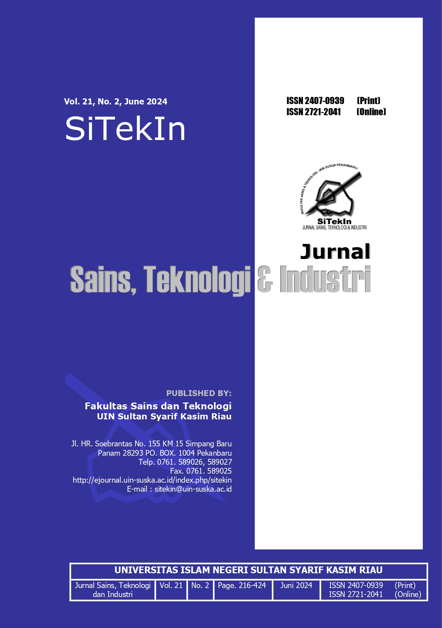RISK MITIGATION IN PLANNING AND WAREHOUSING ACTIVITIES OF FERTILIZER FACTORY SPARE PARTS (Case Study: PT Pupuk Iskandar Muda)
DOI:
https://doi.org/10.24014/sitekin.v21i2.29523Abstract
In meeting the needs of spare parts in a supply chain, the warehouse is one of the most important parts. Warehouses have three main processes, namely receiving, storing, and distributing so, warehouse needs are certainly very important to help companies achieve their goals. This research uses an integrated Fuzzy Logic, House of Risk (HOR), and Supply Chain Operation Reference (SCOR) approach. Interviews, focus discussion groups, and questionnaires are the data collection methods used. From the results of data processing, 19 risk events and 27 risk agents were obtained. From the results of the pareto diagram, 14 risk agents were selected to focus on risk mitigation and have the ability to direct the reduction of risk. Furthermore, 14 risk agents were developed into 28 mitigation strategies and there were 10 prioritized risk mitigation strategies.
Keywords: Risk Mitigation, Warehousing, SCOR, HOR, Fuzzy Logic, Pareto Diagram.
References
Erlina, “Analisa Pengukuran Kinerja Rantai Pasok Dengan Model Supply Chain Operation Reference (SCOR) PT. XYZ Di Bogor,” J. Ilm. Manaj. dan Bisnis (Scientific J. Manag. Business), vol. 4, no. 2, pp. 1–23, 2020, doi: 10.22441/indikator.v4i2.10001.
S. Aćimović, “Understanding the Supply Chain,” Sci. Pap., vol. 51, no. 170, pp. 67–89, 2006, doi: 10.2298/EKA0670067A.
R. A. Hadiguna, Manajemen Rantai Pasok Agroindustri: Pendekatan Berkelanjutan untuk Pengukuran Kinerja dan Penilaian Risiko, 1st ed. Padang: Andalas University Press, 2016.
S. Cebi and E. Ilbahar, “Warehouse risk assessment using interval valued intuitionistic fuzzy AHP,” Int. J. Anal. Hierarchy Process, vol. 10, no. 2, pp. 243–253, 2018, doi: 10.13033/ijahp.v10i2.549.
M. Albar and Winarno, “Analisis Penyebab Terjadinya Selisih Jumlah Persediaan Suku Cadang di Gudang Perusahaan Jasa Alat Berat,” J. Serambi Eng., vol. 8, no. 3, pp. 6365–6370, 2023, doi: 10.32672/jse.v8i3.6247.
K. Jermsittiparsert, J. Sutduean, and T. Sriyakul, “Role of Warehouse Attributes in Supply Chain Warehouse Efficiency in Indonesia,” Int. J. Innov. Creat. Chang., vol. 5, no. 2, pp. 786–802, 2019.
M. İfraz, A. Aktepe, S. Ersöz, and T. Çetinyokuş, “Demand forecasting of spare parts with regression and machine learning methods: Application in a bus fleet,” J. Eng. Res., vol. 11, no. 2, pp. 1–10, 2023, doi: 10.1016/j.jer.2023.100057.
R. Utari, “Perancangan Strategi Mitigasi Resiko Supply Chain Di PT Atlas Copco Nusantara Dengan Metoda House of Risk,” Institut Teknologi Sepuluh Nopember, Surabaya, 2015.
M. F. A. Maulana, “Analisis Manajemen Risiko pada Aktivitas Supply Chain Dengan Pendekatan Supply Chain Risk Management (Studi Kasus: CV. Tunas Karya),” Universitas Islam Indonesia, 2020.
C. S. Tang, “Perspectives in supply chain risk management,” Int. J. Prod. Econ., vol. 103, no. 2, pp. 451–488, 2006, doi: 10.1016/j.ijpe.2005.12.006.
Downloads
Published
Issue
Section
License
This work is licensed under a Creative Commons Attribution-ShareAlike 4.0 International License
Copyright Notice
An author who publishes in the SITEKIN Journal agrees to the following terms:
- Author retains the copyright and grants the journal the right of first publication of the work simultaneously licensed under the Creative Commons Attribution-ShareAlike 4.0 License that allows others to share the work with an acknowledgement of the work's authorship and initial publication in this journal
- Author is able to enter into separate, additional contractual arrangements for the non-exclusive distribution of the journal's published version of the work (e.g., post it to an institutional repository or publish it in a book) with the acknowledgement of its initial publication in this journal.
- Author is permitted and encouraged to post his/her work online (e.g., in institutional repositories or on their website) prior to and during the submission process, as it can lead to productive exchanges, as well as earlier and greater citation of the published work (See The Effect of Open Access).
Read more about the Creative Commons Attribution-ShareAlike 4.0 Licence here: https://creativecommons.org/licenses/by-sa/4.0/.

